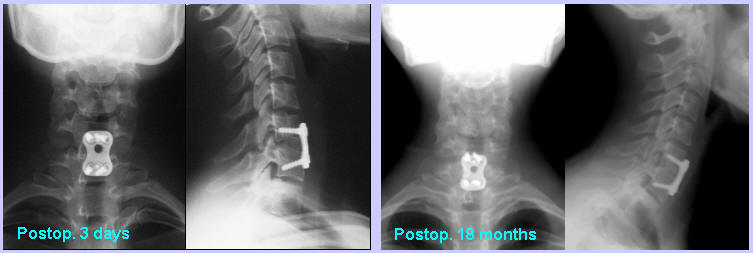|
|
 |
 |
 HOME > 증 례 001 HOME > 증 례 001 |
|
Anterior fusion in Smith-Robinson way was carried out in a slightly distracted position, and fixation with a plate was added. Posterior surgery was not performed. Radiating pain disappeared immediately postoperatively. The postoperative course of the patient was uneventful. Philadelphia bracing was recommended for 3 months, but she abandoned it at 6 weeks after the surgery. At the last follow-up at 18 months after the surgery, there was neither radiating pain nor neck pain, and no neurologic sign of radiculopathy. Simple roentgenograms showed good union of both anterior fusion site and the fracture site.

|
|
 |
The fracture of an articular process of the cervical spine without dislocation or subluxation is rare and can be easily overlooked or misdiagnosed as a cervical disc herniation. Clinical manifestations of this case were the same as those of a cervical disc herniation: neurologic signs of C7 radiculopathy and even Spurling’s sign and shoulder abduction pain relief test were positive. Even the lateral roentgenogram showed disc space narrowing. We have recently experienced two more cases of articular process fracture which were neglected in other hospitals.
Posterior surgery including decompression, fixation, and bone graft is a usual and logical treatment for this fracture when it causes radiculopathy. However, since the superior articular process is located anterior to the inferior articular process, the latter must be removed first for posterior decompression. Furthermore, since the fracture fragment was relatively large in this case, the decompression process could be too destructive and posterior fixation could be unsatisfactory or not stable enough, and additional anterior fusion could be required after the posterior surgery.
I thought that simple anterior fusion in a distracted position could be a good alternative to a more complicated posterior surgery in this case where the displacement was not so severe. The same principle of ligamentotaxis as is applied in the treatment of the thoracolumbar burst fractures was tried in this case and resulted in an excellent outcome: it is inferred that distraction resulted in widening of the intervertebral foramen and stabilization of the fracture fragment in a reduced position.
<Back>
|
|
|
|


